Boyle J.A. The Cambridge History of Iran, Volume 5: The Saljuq and Mongol Periods
Подождите немного. Документ загружается.

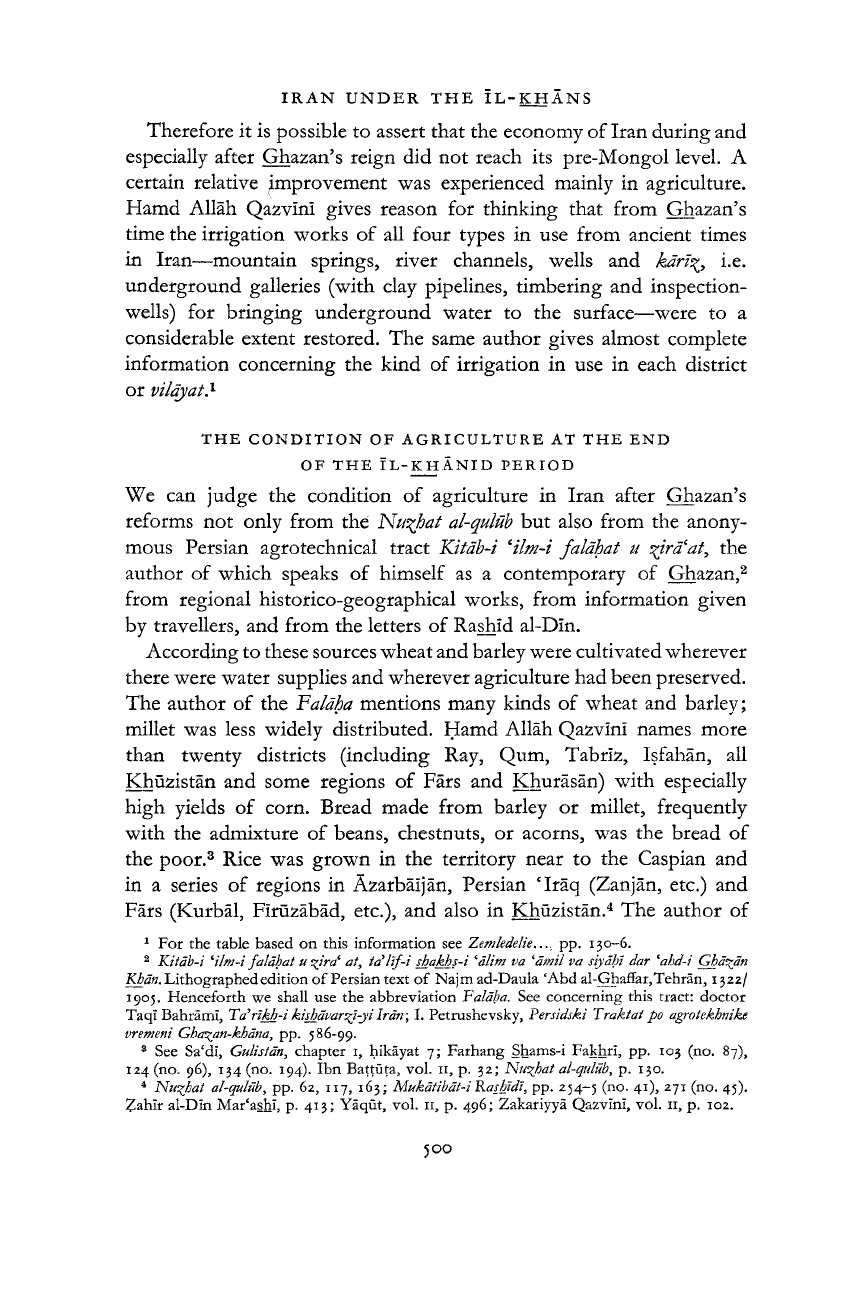
IRAN
UNDER
THE
IL-KHANS
500
Therefore
it
is possible
to
assert
that
the economy of
Iran
during and
especially
after Ghazan's reign
did not
reach
its
pre-Mongol
level.
A
certain relative improvement
was
experienced mainly
in
agriculture.
Hamd
Allah
Qazvini
gives
reason
for
thinking
that
from Ghazan's
time the irrigation works
of
all four types
in use
from ancient times
in Iran—mountain springs, river channels,
wells
and kdn\, i.e.
underground galleries (with
clay
pipelines, timbering
and
inspection-
wells)
for
bringing underground water
to the
surface—were
to a
considerable extent restored.
The
same author
gives
almost complete
information concerning
the
kind
of
irrigation
in use in
each district
or vildjat.
1
THE CONDITION
OF
AGRICULTURE
AT THE END
OF
THE
IL-KHANID PERIOD
We
can
judge
the
condition
of
agriculture
in
Iran
after Ghazan's
reforms
not
only from
the
Nu^hat al-qulub
but
also from
the
anony-
mous Persian agrotechnical tract Kitdb-i
c
ilm-i faldhat
u
%ird
6
at
y
the
author
of
which speaks
of
himself
as a
contemporary
of
Ghazan,
2
from regional historico-geographical works, from information
given
by
travellers,
and
from the letters
of
Rashid al-Din.
According
to these sources wheat and barley were cultivated wherever
there were water supplies and wherever agriculture had been preserved.
The
author
of the
Faldha mentions many kinds
of
wheat
and
barley;
millet was less
widely
distributed. Hamd
Allah
Qazvini names more
than
twenty districts (including
Ray, Qum,
Tabriz, Isfahan,
all
Khuzistan
and
some regions
of
Fars
and
Khurasan) with especially
high yields
of
corn. Bread made from barley
or
millet, frequently
with
the
admixture
of
beans, chestnuts,
or
acorns,
was the
bread
of
the poor.
3
Rice
was
grown
in the
territory near
to the
Caspian
and
in
a
series
of
regions
in
Azarbaijan, Persian
"Iraq
(Zanjan, etc.)
and
Fars (Kurbal, Firuzabad, etc.),
and
also
in
Khuzistan.
4
The author
of
1
For the
table based
on
this
information
see Zemledelie..., pp. 130-6.
2
Kitdb-i
Q
ilm-i faldhat
u
%ira
(
at, ta
y
lif-i shakhs-i
l
dlim va
*amil
va siydhi dar
(
ahd-i Ghazan
Khan.
Lithographed edition
of
Persian text
of
Najm ad-Daula 'Abd al-Ghaffar, Tehran,
1322/
1905. Henceforth
we
shall
use the
abbreviation
Faldha. See
concerning
this
tract:
doctor
Taqi
Bahrami,
Tarikh-i kishdvar^i-yi Iran;
I.
Petrushevsky,
Persidski
Traktat
po agrotekhnike
vremeni Gha^an-khdna, pp. 586-99.
3
See
Sa'di,
Gulistdn,
chapter
1,
hikayat
7;
Farhang Shams-i Fakhri,
pp. 103 (no. 87),
124 (no.
96), 134
(no.
194). Ibn
Battuta, vol. 11,
p. 32;
Nu^hat
al-qulub,
p. 130.
4
Nu^hat
al-qulub, pp. 62,
117,
163; Mukatibat-i RashidI, pp. 254-5 (no. 41), 271
(no.
45).
Zahir al-Din Mar
c
ashi,
p. 413;
Yaqut, vol. 11,
p. 496;
Zakariyya Qazvini, vol. 11,
p. 102.
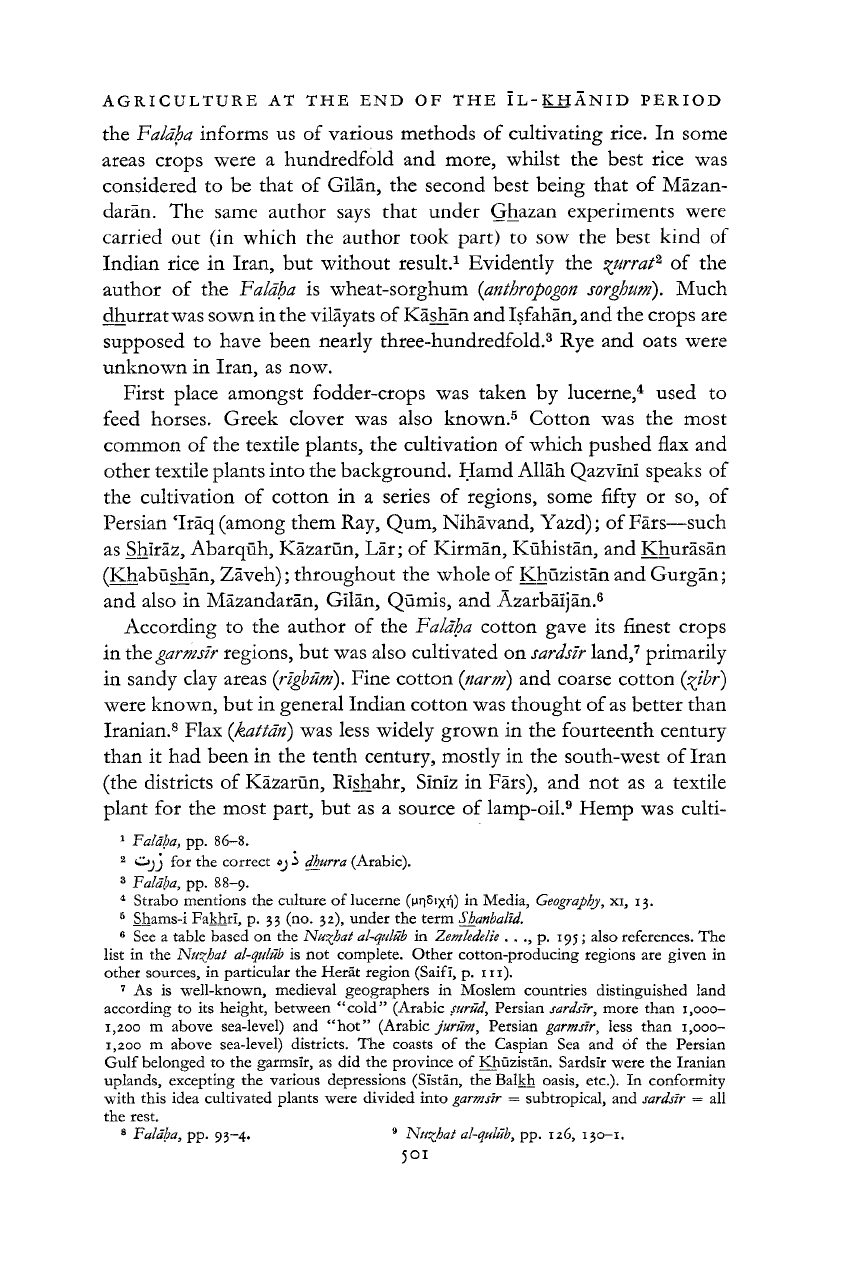
AGRICULTURE AT THE END OF THE IL-KHANID PERIOD
the Faldha informs us of various methods of cultivating rice. In some
areas crops were a hundredfold and more, whilst the best rice was
considered to be that of Gilan, the second best being that of Mazan-
daran. The same author says that under Ghazan experiments were
carried out (in which the author took part) to sow the best kind of
Indian rice in Iran, but without result.
1
Evidently the %urrat
2
of the
author of the Faldha is wheat-sorghum
(anthropogon
sorghum).
Much
dhurrat was sown in the vilayats of Kashan and Isfahan, and the crops are
supposed to have been nearly three-hundredfold.
3
Rye and oats were
unknown in Iran, as now.
First place amongst fodder-crops was taken by lucerne,
4
used to
feed horses, Greek clover was also known.
5
Cotton was the most
common of the textile plants, the cultivation of which pushed flax and
other textile plants into the background. Hamd Allah Qazvini speaks of
the cultivation of cotton in a series of regions, some fifty or so, of
Persian "Iraq (among them Ray, Qum, Nihavand, Yazd); of Fars—such
as Shiraz, Abarquh, Kazarun, Lar; of Kirman, Kuhistan, and Khurasan
(Khabushan, Zaveh); throughout the whole of Khuzistan and Gurgan;
and also in Mazandaran, Gilan, Qumis, and Azarbaijan.
6
According to the author of the Faldha cotton gave its finest crops
in the
garmslr
regions, but was also cultivated on
sardsir
land,
7
primarily
in sandy clay areas
(rlghum).
Fine cotton
(narm)
and coarse cotton (gibr)
were known, but in general Indian cotton was thought of as better than
Iranian.
8
Flax (kattdn) was less widely grown in the fourteenth century
than it had been in the tenth century, mostly in the south-west of Iran
(the districts of Kazarun, Rishahr, Siniz in Fars), and not as a textile
plant for the most part, but as a source of lamp-oil.
9
Hemp was culti-
1
Faldha, pp. 86-8.
2
*"UJ f°
r tne
correct oj b
dhurra
(Arabic).
3
Faldha, pp. 88-9.
4
Strabo mentions the culture of lucerne (цг)
5і
Хл) in Media,
Geography,
xi, 13.
6
Shams-i Fakhri, p. 33 (no. 32), under the term Shanbalid.
6
See a table based on the
Nu-^hat al-qulub
in Zemledelie . . ., p. 195; also references. The
list in the Nu^hat al-qulub is not complete. Other cotton-producing regions are given in
other sources, in particular the Herat region (Saifi, p. in).
7
As is well-known, medieval geographers in Moslem countries distinguished land
according to its height, between "cold" (Arabic surud, Persian sardsir, more than 1,000-
1,200 m above sea-level) and "hot" (Arabic jurum, Persian garmslr, less than 1,000-
1,200 m above sea-level) districts. The coasts of the Caspian Sea and of the Persian
Gulf belonged to the garmslr, as did the province of Khuzistan. Sardsir were the Iranian
uplands, excepting the various depressions (Sistan, the Balkh oasis, etc.). In conformity
with this idea cultivated plants were divided into garmslr = subtropical, and sardsir = all
the rest.
8
Faldha, pp. 93-4.
9
Nu^hat al-qulub, pp. 126, 130-1.
501
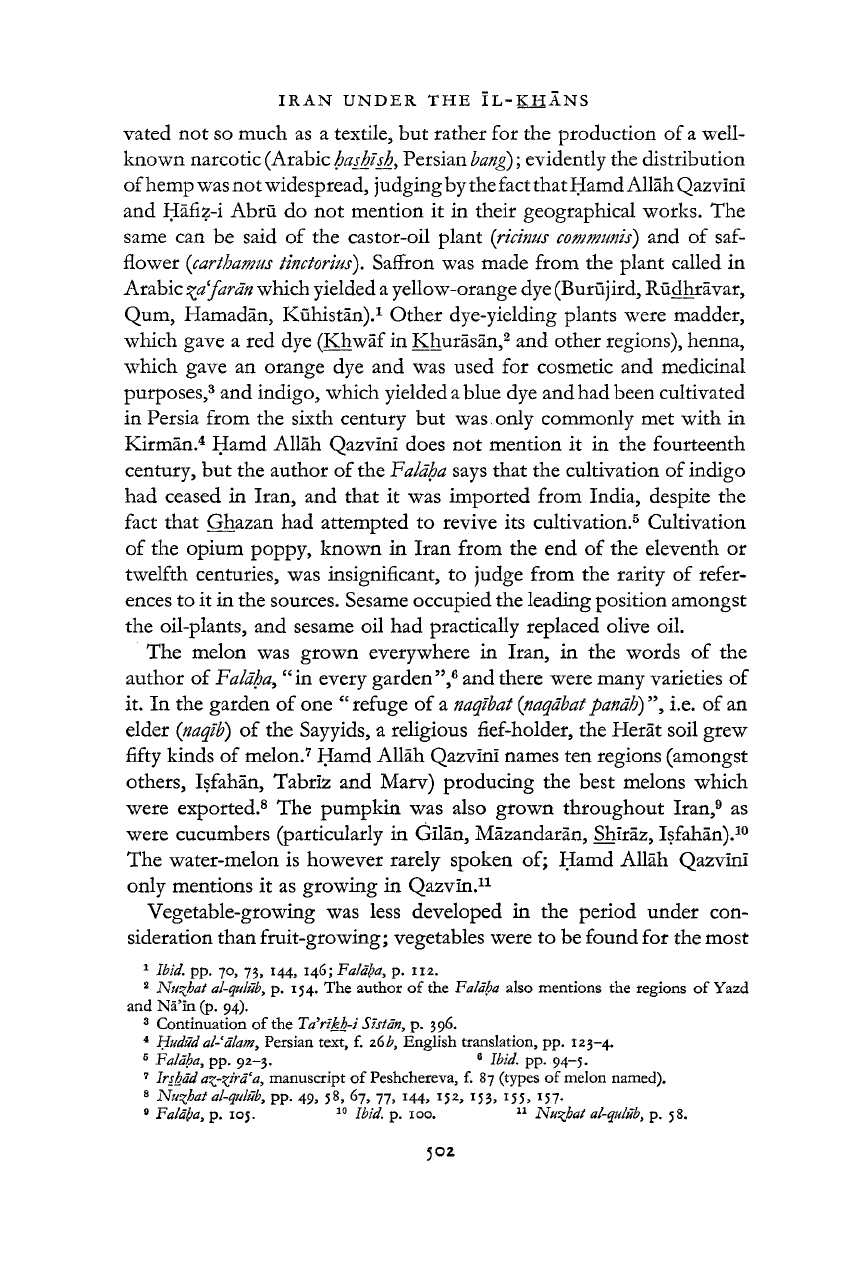
IRAN UNDER THE ÏL-KHANS
vated not so much as a textile, but rather for the production of a well-
known narcotic (Arabic
hashish,
Persian bang); evidently the distribution
of hemp was not widespread, judging by the fact that Hamd Allah Qazvïnï
and Hafiz-i Abrü do not mention it in their geographical works. The
same can be said of the castor-oil plant (ricinus
communis)
and of saf-
flower
{carthamus
tine tortus). Saffron was made from the plant called in
Arabic
%a'far՝dn
which yielded a yellow-orange dye (Burüjird, Rüdhràvar,
Qum, Hamadàn, Kühistàn).
1
Other dye-yielding plants were madder,
which gave a red dye (Khwàf in Khurasan,
2
and other regions), henna,
which gave an orange dye and was used for cosmetic and medicinal
purposes,
3
and indigo, which yielded a blue dye and had been cultivated
in Persia from the sixth century but was.only commonly met with in
Kirman.
4
Hamd Allah Qazvïnï does not mention it in the fourteenth
century, but the author of the Faldha says that the cultivation of indigo
had ceased in Iran, and that it was imported from India, despite the
fact that Ghazan had attempted to revive its cultivation.
5
Cultivation
of the opium poppy, known in Iran from the end of the eleventh or
twelfth centuries, was insignificant, to judge from the rarity of refer-
ences to it in the sources. Sesame occupied the leading position amongst
the oil-plants, and sesame oil had practically replaced olive oil.
The melon was grown everywhere in Iran, in the words of the
autho
r of Fa/dha
9
"in every garden",
6
and there were many varieties of
it.
In the garden of one " refuge of a
naqlbat
(naqdbat pandh)i.e. of an
elder (naqlb) of the Sayyids, a religious fief-holder, the Herat soil grew
fifty kinds of melon.
7
Hamd Allah Qazvïnï names ten regions (amongst
others, Isfahan, Tabriz and Marv) producing the best melons which
were exported.
8
The pumpkin was also grown throughout Iran,
9
as
were cucumbers (particularly in Gïlàn, Màzandaràn, Shïràz, Isfahan).
10
The water-melon is however rarely spoken of; Hamd Allah Qazvïnï
only mentions it as growing in Qazvin.
11
Vegetable-growing was less developed in the period under con-
sideration than fruit-growing; vegetables were to be found for the most
1
Ibid. pp. 70, 73, 144, 146; Faldfra, p. 112.
2
Nu^hat al-qulüb, p. 154. The author of the Faldha also mentions the regions of Ya2d
and Nà'ïn (p. 94).
3
Continuation of the Ta'rlkh-i Sïstdn, p. 396.
4
Hudüd al-àlam
y
Persian text, f. 26 b, English translation, pp. 123-4.
5
Faldha^
pp. 92-3.
6
Ibid. pp. 94-5.
7
Irs had az-zira'a, manuscript of Peshchereva, f. 87 (types of melon named).
8
Nu^hat al-qulüb, pp. 49, 58, 67, 77, 144, 152, 153, 155, 157.
9
Fa/di>a
9
p. 105.
10
Ibid. p. 100.
11
Nu^hat
al֊qulüb
)
p. 58.
502
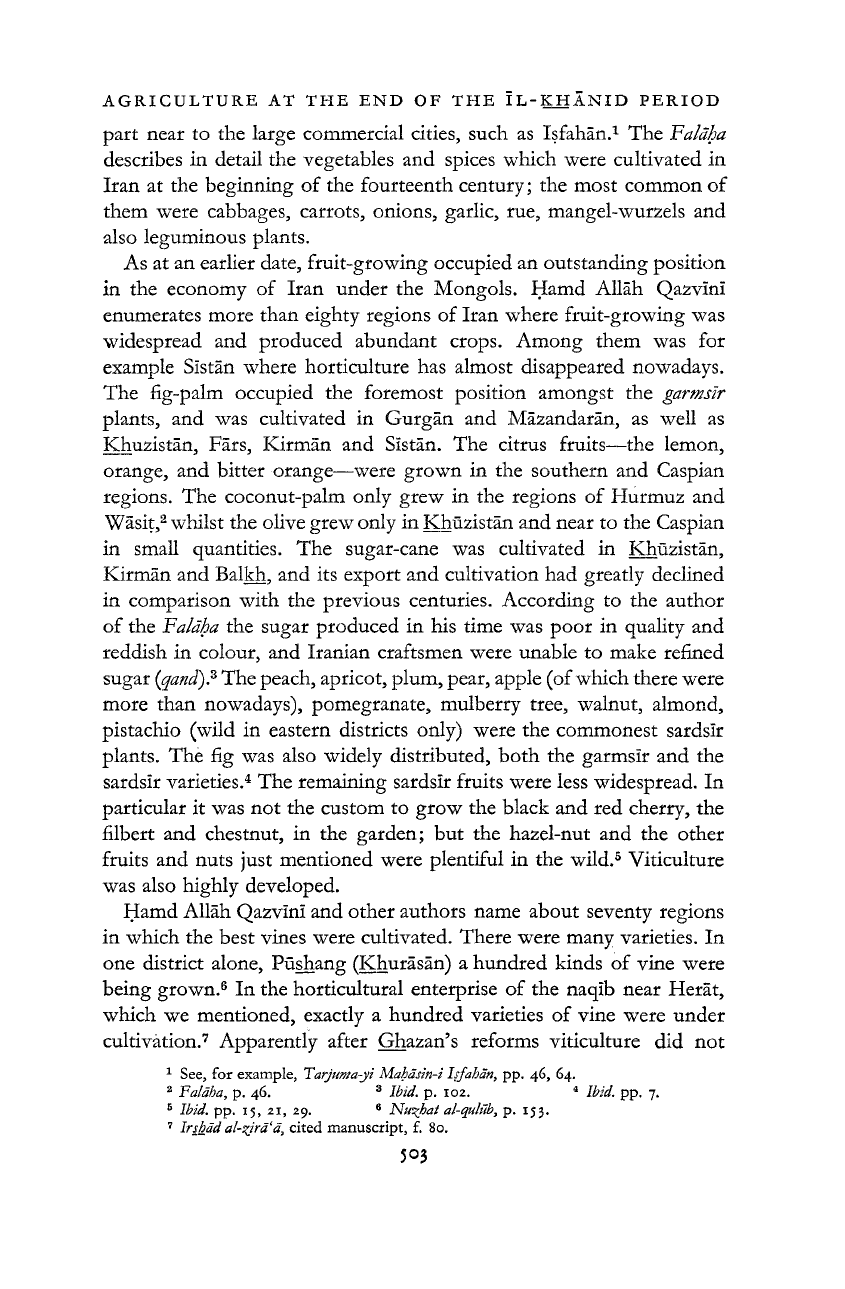
AGRICULTURE AT THE END OF THE ÏL-KHANID PERIOD
part near to the large commercial cities, such as Isfahan.
1
The Faldha
describes in detail the vegetables and spices which were cultivated in
Iran at the beginning of the fourteenth century; the most common of
them were cabbages, carrots, onions, garlic, rue, mangel-wurzels and
also leguminous plants.
As at an earlier date, fruit-growing occupied an outstanding position
in the economy of Iran under the Mongols. Hamd Allah Qazvïnï
enumerates more than eighty regions of Iran where fruit-growing was
widespread and produced abundant crops. Among them was for
example Sïstàn where horticulture has almost disappeared nowadays.
The fig-palm occupied the foremost position amongst the garmstr
plants, and was cultivated in Gurgan and Màzandaràn, as well as
Khuzistàn, Fars, Kirman and Sïstàn. The citrus fruits—the lemon,
orange, and bitter orange—were grown in the southern and Caspian
regions. The coconut-palm only grew in the regions of Hurmuz and
Wàsit,
2
whilst the olive grew only in Khuzistàn and near to the Caspian
in small quantities. The sugar-cane was cultivated in Khüzistan,
Kirman and Balkh, and its export and cultivation had greatly declined
in comparison with the previous centuries. According to the author
of the Faldha the sugar produced in his time was poor in quality and
reddish in colour, and Iranian craftsmen were unable to make refined
sugar (gand)? The peach, apricot, plum, pear, apple (of which there were
more than nowadays), pomegranate, mulberry tree, walnut, almond,
pistachio (wild in eastern districts only) were the commonest sardsïr
plants. The fig was also widely distributed, both the garmsir and the
sardsïr varieties.
4
The remaining sardsïr fruits were less widespread. In
particular it was not the custom to grow the black and red cherry, the
filbert and chestnut, in the garden; but the hazel-nut and the other
fruits and nuts just mentioned were plentiful in the wild.
5
Viticulture
was also highly developed.
Hamd Allah Qazvïnï and other authors name about seventy regions
in which the best vines were cultivated. There were many varieties. In
one district alone, Püshang (Khurasan) a hundred kinds of vine were
being grown.
6
In the horticultural enterprise of the naqib near Herat,
which we mentioned, exactly a hundred varieties of vine were under
cultivation.
7
Apparently after Ghazan's reforms viticulture did not
1
See, for example, Tarjuma-yi Mahdsin-i Isfahan, pp. 46, 64.
2
Faldha, p. 46.
3
Ibid. p. 102.
4
Ibid, pp. 7.
5
Ibid. pp. 15, 21, 29.
6
Nu^hat al-qulüb, p. 153.
7
Irs had al-^ird'd, cited manuscript, f. 80.
503
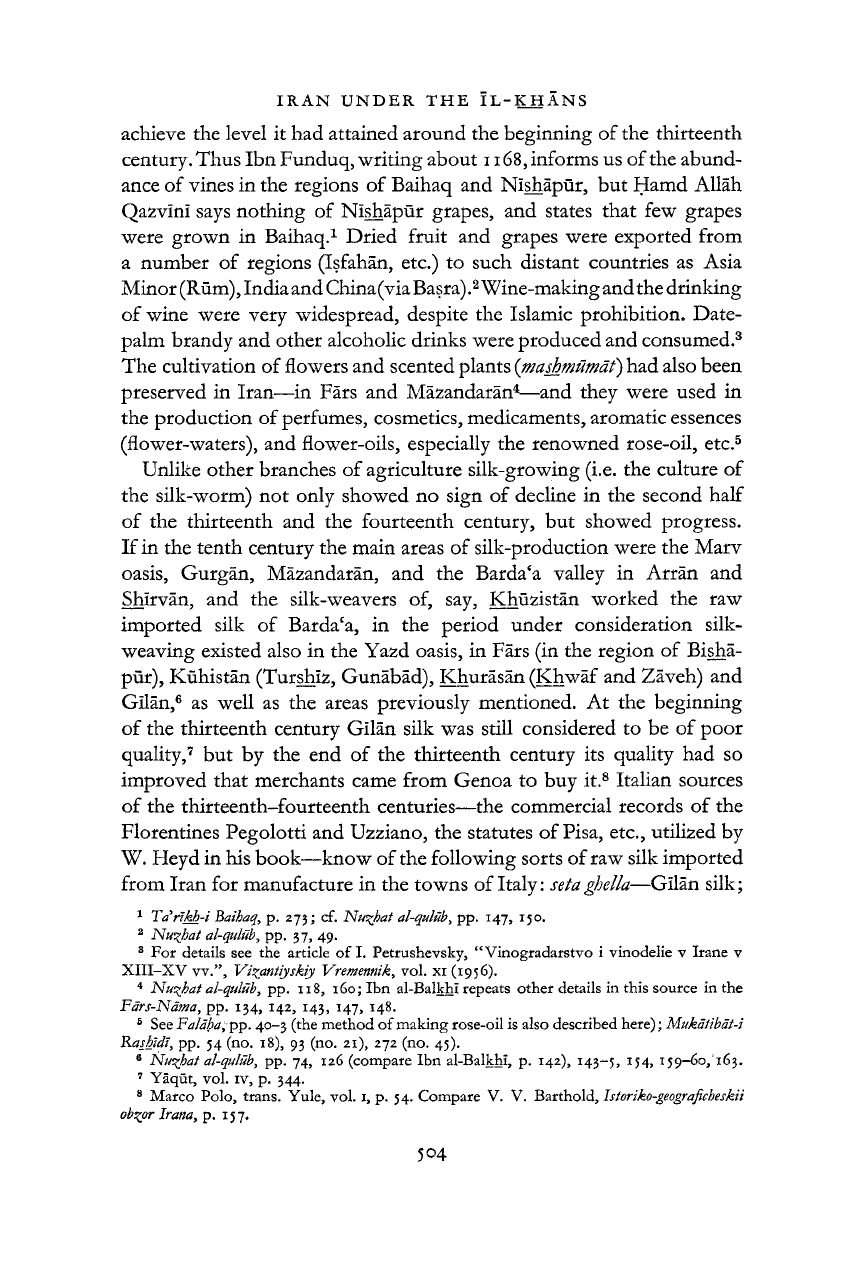
IRAN UNDER THE IL-KHANS
504
achieve the level it had attained around the beginning of the thirteenth
century. Thus Ibn Funduq, writing about
1168,
informs us of the abund-
ance of vines in the regions of Baihaq and Nishapur, but Hamd Allah
Qazvini says nothing of Nishapur grapes, and states that few grapes
were grown in Baihaq.
1
Dried fruit and grapes were exported from
a number of regions (Isfahan, etc.) to such distant countries as Asia
Minor
(Rum),
India and China (via
Basra).
2
Wine-making and the drinking
of wine were very widespread, despite the Islamic prohibition. Date-
palm brandy and other alcoholic drinks were produced and consumed.
3
The cultivation of flowers and scented plants
(mashmumdf)
had also been
preserved in Iran—in Fars and Mazandaran
4
—and they were used in
the production of perfumes, cosmetics, medicaments, aromatic essences
(flower-waters), and flower-oils, especially the renowned rose-oil, etc.
5
Unlike other branches of agriculture silk-growing (i.e. the culture of
the silk-worm) not only showed no sign of decline in the second half
of the thirteenth and the fourteenth century, but showed progress.
If in the tenth century the main areas of silk-production were the Marv
oasis,
Gurgan, Mazandaran, and the Barda
c
a valley in Arran and
Shirvan, and the silk-weavers of, say,
Khuzistan worked the raw
imported silk of Barda'a, in the period under consideration silk-
weaving existed also in the Yazd oasis, in Fars (in the region of Bisha-
pur),
Kuhistan (Turshiz, Gunabad), Khurasan (Khwaf and Zaveh) and
Gilan,
6
as well as the areas previously mentioned. At the beginning
of the thirteenth century Gilan silk was still considered to be of poor
quality,
7
but by the end of the thirteenth century its quality had so
improved that merchants came from Genoa to buy it.
8
Italian sources
of the thirteenth-fourteenth centuries—the commercial records of the
Florentines Pegolotti and Uzziano, the statutes of Pisa, etc., utilized by
W. Heyd in his book—know of the following sorts of raw silk imported
from Iran for manufacture in the towns of Italy: setaghella—Gilan silk;
1
Ta'rfkh-i
Baihaq,
p. 273; cf. Nu^hat al-quliib, pp. 147, 150.
2
Nu^hat al-qulub, pp. 37, 49.
8
For details see the article of I. Petrushevsky, "Vinogradarstvo i vinodelie v Irane v
XIII-XV vv.", Vi^antiyskiy Vremennik, vol. xi (1956).
4
Nu^hat al-qulub, pp. 118, 160; Ibn al-Balkhi repeats other details in this source in the
Fdrs-Ndma, pp. 134, 142, 143, 147, 148.
5
See Faldba,pp. 40-3 (the method of making rose-oil is also described here); Mukdtibdt-i
RasbidJ, pp. 54 (no. 18), 93 (no. 21), 272 (no. 45).
6
Nu^bat al-qulub, pp. 74, 126 (compare Ibn al-Balkhi, p. 142), 143-5, 154, 159-60, 163.
7
Yaqut, vol. iv, p. 344.
8
Marco Polo, trans. Yule, vol. 1, p. 54. Compare V. V. Barthold,
htoriko-geograficheskii
ob^pr
Irana, p. 157.
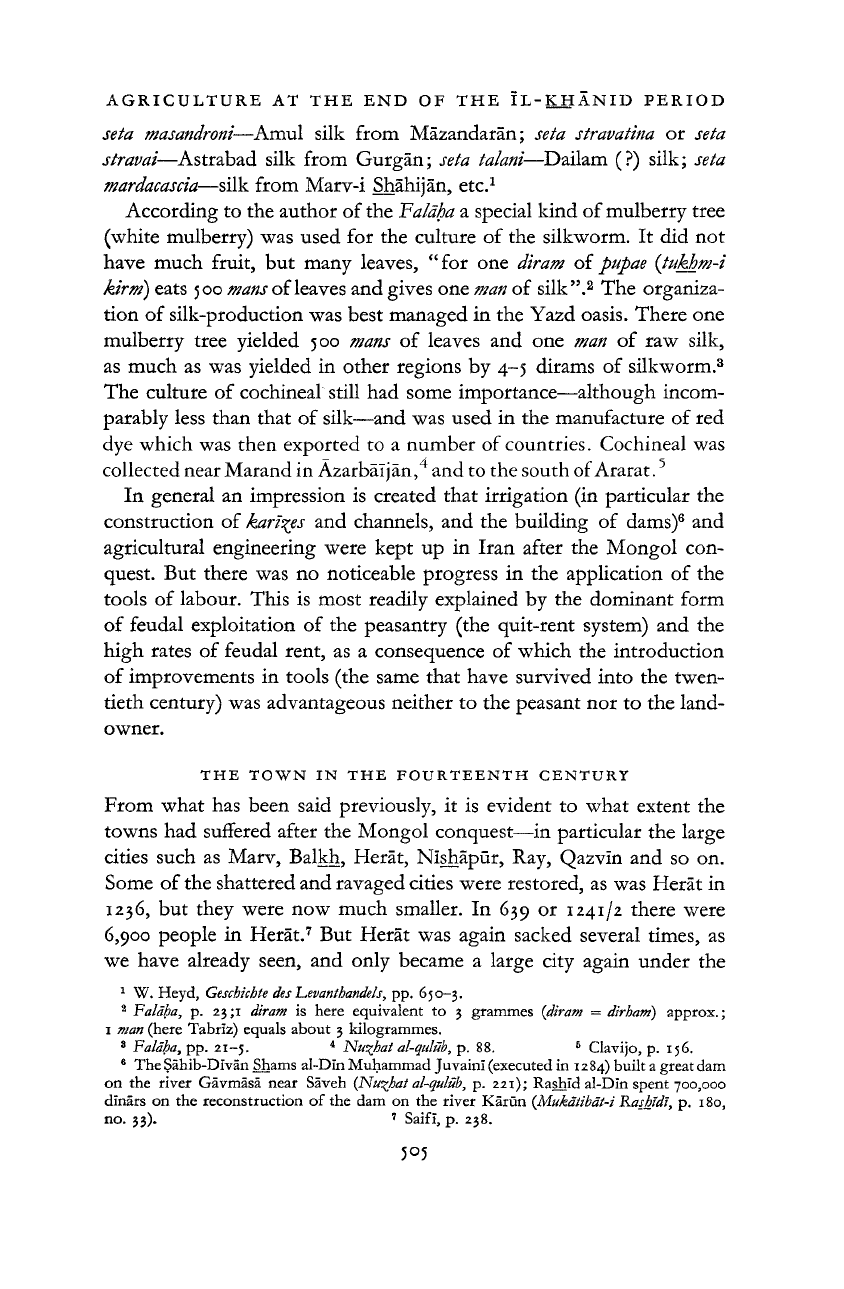
AGRICULTURE AT THE END OF THE ĪL-KHĀNID PERIOD
505
seta masandroni—Amul silk from Māzandarān; seta stravatina or seta
strāvai—Astrabad silk from Gurgān; seta talani—Daiļam (?) silk; seta
mardacascia—silk from Marv-i
Shāhijān, etc.
1
According to the author of the Falāha a special kind of mulberry tree
(white mulberry) was used for the culture of the silkworm. It did not
have much fruit, but many leaves, "for one diram of pupae
(tukhm֊i
kirm) eats 500
mans
of leaves and gives one
man
of silk".
2
The organiza-
tion of silk-production was best managed in the Yazd oasis. There one
mulberry tree yielded 500 mans of leaves and one man of raw silk,
as much as was yielded in other regions by 4-5 dirams of silkworm.
3
The culture of cochineal still had some importance—although incom-
parably less than that of silk—and was used in the manufacture of red
dye which was then exported to a number of countries. Cochineal was
collected near Marand in
Āzarbāījān,
4
and to the south of Ararat.
5
In general an impression is created that irrigation (in particular the
construction of
karītŗes
and channels, and the building of dams)
6
and
agricultural engineering were kept up in Iran after the Mongol con-
quest. But there was no noticeable progress in the application of the
tools of labour. This is most readily explained by the dominant form
of feudal exploitation of the peasantry (the quit-rent system) and the
high rates of feudal rent, as a consequence of which the introduction
of improvements in tools (the same that have survived into the twen-
tieth century) was advantageous neither to the peasant nor to the land-
owner.
THE TOWN IN THE FOURTEENTH CENTURY
From what has been said previously, it is evident to what extent the
towns had suffered after the Mongol conquest—in particular the large
cities such as Marv,
Balķh, Herat, Nīshāpūr, Ray, Qazvln and so on.
Some of the shattered and ravaged cities were restored, as was Herat in
1236,
but they were now much smaller. In 639 or 1241/2 there were
6,900 people in Herat.
7
But Herat was again sacked several times, as
we have already seen, and only became a large city again under the
1
W. Heyd,
Geschichte des
Levanthande/s,
pp. 650-3.
2
Falāha, p. 23 ;i diram is here equivalent to 3 grammes (diram = dirham) approx.;
1
man
(here Tabriz) equals about 3 kilogrammes.
8
Fa/aha, pp. 21-5.
4
Nuŗhat al-qidub, p. 88.
5
Clavijo, p. 156.
6
The Sāhib-Dīvān Shams al-Dīn Muhammad JuvainI (executed in 1284) built a great dam
on the river Gāvmāsā near Sāveh (Nuŗhat al-qulūb
}
p. 221); Rashīd al-Dīn spent 700,000
dinārs on the reconstruction of the dam on the river Kārūn (Mukātibāt-i Rashtdl, p. 180,
no.
33).
7
Saifi, p. 238.
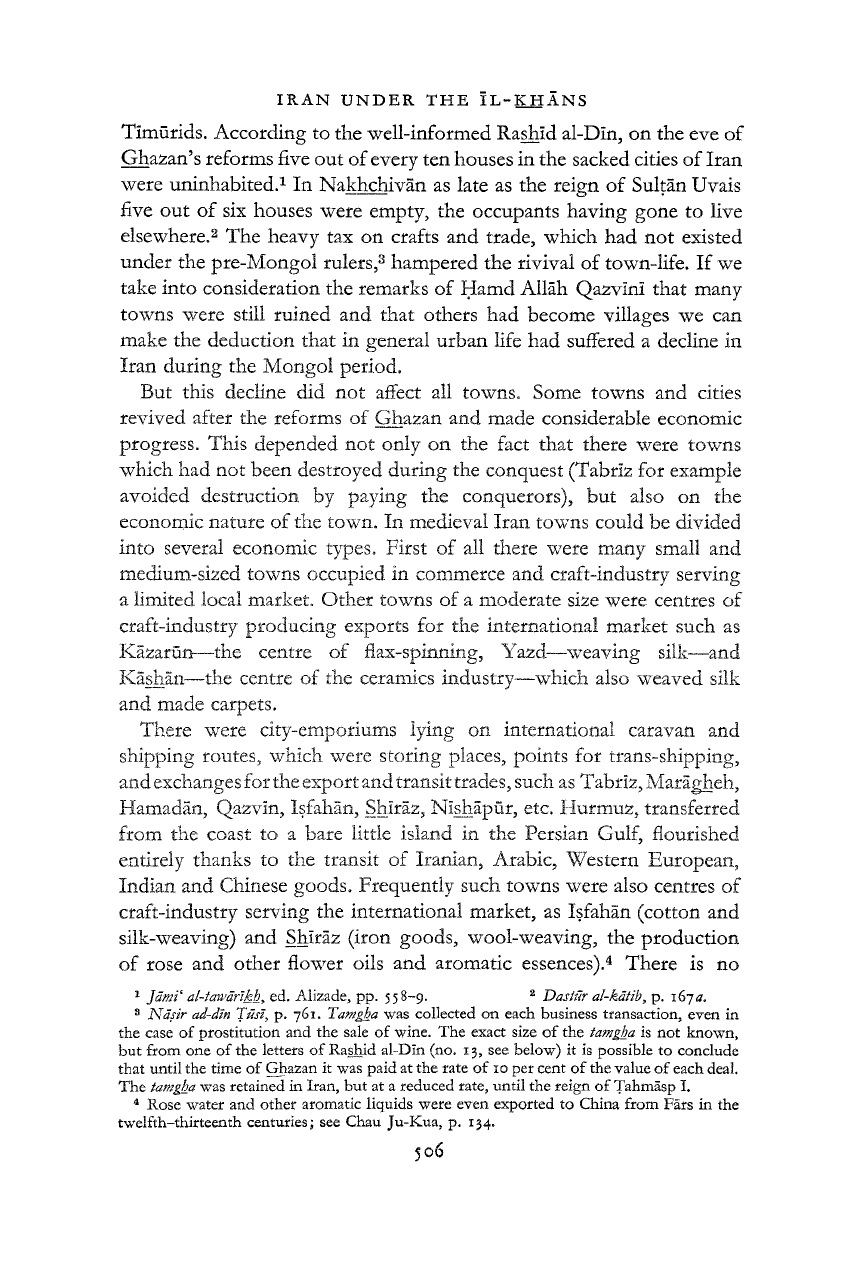
IRAN UNDER THE ĪL-KHĀNS
506
Tīmūrids. According to the well-informed Rashīd al-Dīn, on the eve of
Ghazan's reforms five out of every ten houses in the sacked cities of Iran
were uninhabited.
1
In Nakhchivān as late as the reign of Sultan Uvais
five out of six houses were empty, the occupants having gone to live
elsewhere.
2
The heavy tax on crafts and trade, which had not existed
under the pre-Mongol rulers,
3
hampered the rivival of town-life. If we
take into consideration the remarks of Hamd Allāh Qazvmi that many
towns were still ruined and that others had become villages we can
make the deduction that in general urban life had suffered a decline in
Iran during the Mongol period.
But this decline did not affect all towns. Some towns and cities
revived after the reforms of Ghazan and made considerable economic
progress. This depended not only on the fact that there were towns
which had not been destroyed during the conquest (Tabriz for example
avoided destruction by paying the conquerors), but also on the
economic nature of the town. In medieval Iran towns could be divided
into several economic types. First of all there were many small and
medium-sized towns occupied in commerce and craft-industry serving
a limited local market. Other towns of a moderate size were centres of
craft-industry producing exports for the international market such as
Kāzarūn—the centre of flax-spinning, Yazd—weaving silk—and
Kāshān—the centre of the ceramics industry—which also weaved silk
and made carpets.
There were city-emporiums lying on international caravan and
shipping routes, which were storing places, points for trans-shipping,
and exchanges for the export and transit
trades,
such as Tabriz, Marāgheh,
Hamadān, Qazvin, Isfahan, Shīrāz, Nīshāpūr, etc. Hurmuz, transferred
from the coast to a bare little island in the Persian
Gulf,
flourished
entirely thanks to the transit of Iranian, Arabic, Western European,
Indian and Chinese goods. Frequently such towns were also centres of
craft-industry serving the international market, as Isfahan (cotton and
silk-weaving) and Shīrāz (iron goods, wool-weaving, the production
of rose and other flower oils and aromatic essences).
4
There is no
1
J āmi' al-tawārīķh
y
ed. Alizade, pp. 558-9.
2
Dastūr al-kātib
y
p.
167*7.
8
Naşir
ad-dīn
Tüsî, p. 761. Tamgha was collected on each business transaction, even in
the case of prostitution and the sale of wine. The exact size of the
tamgha
is not known,
but from one of the letters of Raşhid al-Dīn (no. 13, see below) it is possible to conclude
that until the time of Ghazan it was paid at the rate of 10 per cent of the value of each deal.
The
tamgha
was retained in Iran, but at a reduced rate, until the reign of Tahmāsp I.
4
Rose water and other aromatic liquids were even exported to China from Fārs in the
twelfth-thirteenth centuries; see Chau Ju-Kua, p. 134.
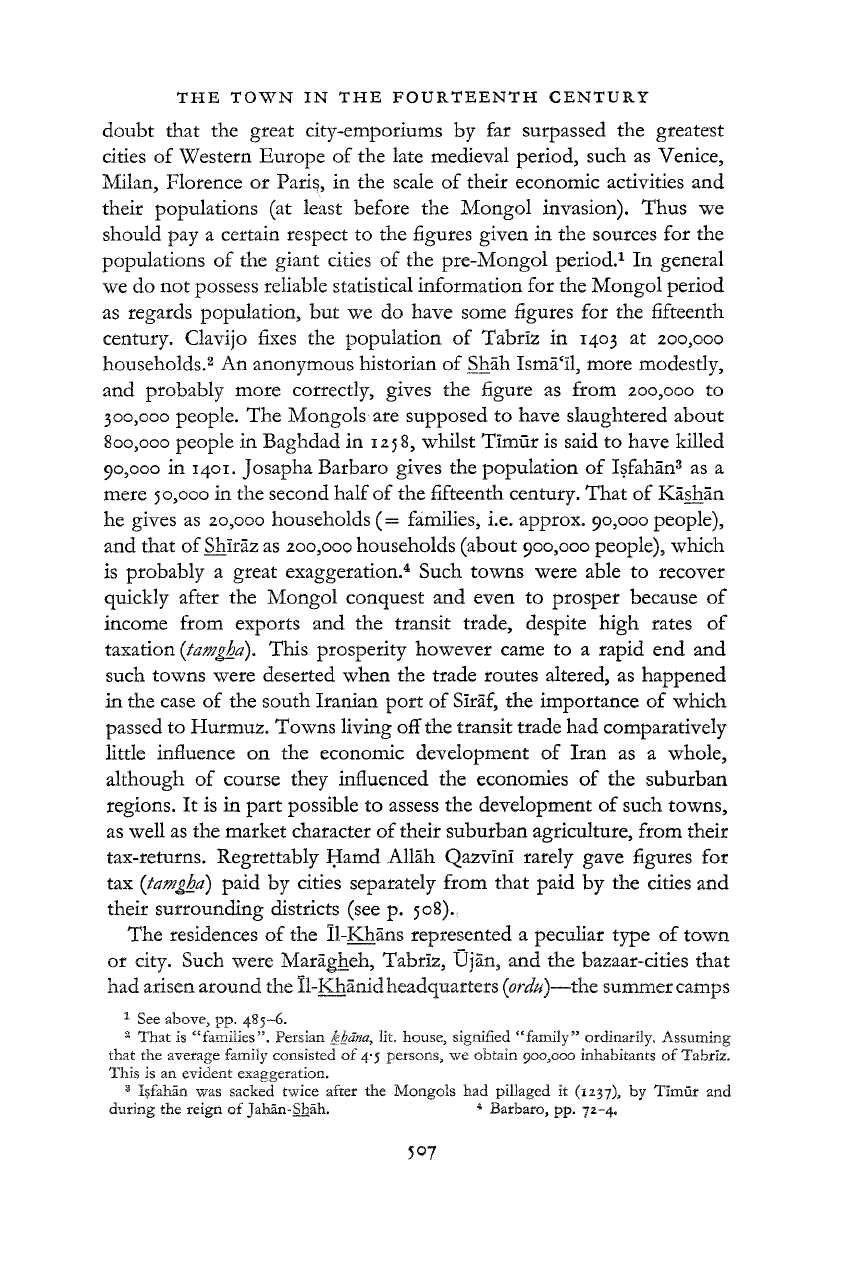
THE TOWN IN THE FOURTEENTH CENTURY
507
doubt that the great city-emporiums by far surpassed the greatest
cities of Western Europe of the late medieval period, such as Venice,
Milan, Florence or Paris, in the scale of their economic activities and
their populations (at least before the Mongol invasion). Thus we
should pay a certain respect to the figures given in the sources for the
populations of the giant cities of the pre-Mongol period.
1
In general
we do not possess reliable statistical information for the Mongol period
as regards population, but we do have some figures for the fifteenth
century. Clavijo fixes the population of Tabriz in 1403 at 200,000
households.
2
An anonymous historian of Shah Isma'Il, more modestly,
and probably more correctly, gives the figure as from 200,000 to
300,000 people. The Mongols are supposed to have slaughtered about
800,000 people in Baghdad in 1258, whilst Tlmur is said to have killed
90,000 in 1401. Josapha Barbaro gives the population of Isfahan
3
as a
mere
5
0,000 in the second half of the fifteenth century. That of Kashan
he gives as 20,000 households (= families, i.e. approx. 90,000 people),
and that of Shiraz as 200,000 households (about 900,000 people), which
is probably a great exaggeration.
4
Such towns were able to recover
quickly after the Mongol conquest and even to prosper because of
income from exports and the transit trade, despite high rates of
taxation
(tamgha).
This prosperity however came to a rapid end and
such towns were deserted when the trade routes altered, as happened
in the case of the south Iranian port of
Siraf,
the importance of which
passed to Hurmuz. Towns living off the transit trade had comparatively
little influence on the economic development of Iran as a whole,
although of course they influenced the economies of the suburban
regions. It is in part possible to assess the development of such towns,
as well as the market character of their suburban agriculture, from their
tax-returns. Regrettably Hamd Allah Qazvini rarely gave figures for
tax
{tamghd)
paid by cities separately from that paid by the cities and
their surrounding districts (see p. 508).
The residences of the Il-Khans represented a peculiar type of town
or city. Such were Maragheh, Tabriz, Ujan, and the bazaar-cities that
had arisen around the Il-Khanid headquarters (prdu)—the summer camps
1
See above, pp. 485-6.
2
That is "families". Persian khdna, lit. house, signified "family" ordinarily. Assuming
that the average family consisted of 4-5 persons, we obtain 900,000 inhabitants of Tabriz.
This is an evident exaggeration.
3
Isfahan was sacked twice after the Mongols had pillaged it (1237), by Tlmur and
during the reign of Jahan-Shah.
4
Barbaro, pp. 72-4.
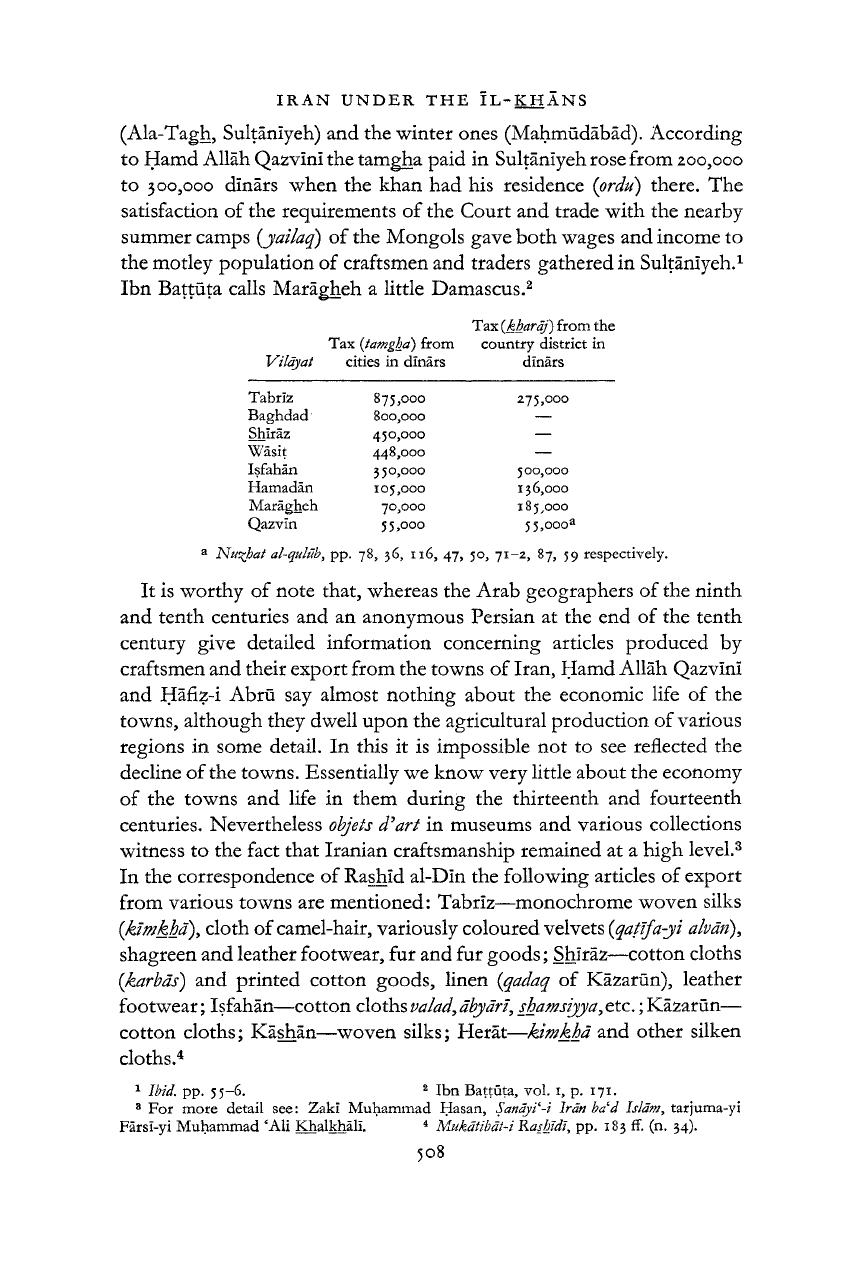
IRAN UNDER THE IL-KHANS
Vildyat
cities in dinars dinars
Tabriz
875,000 275,000
Baghdad 800,000
—
Shïraz
450,000
—
Wasit
448,000
—
Isfahan
350,000
500,000
Hamadán
105,000
136,000
Marágheh
70,000 185,000
Qazvïn 55,000
55,000'
a
Nu^hat al-qulüb
>
pp. 78, 36, 116, 47, 50, 71-2, 87, 59 respectively.
It is worthy of note that, whereas the Arab geographers of the ninth
and tenth centuries and an anonymous Persian at the end of the tenth
century give detailed information concerning articles produced by
craftsmen and their export from the towns of Iran, Hamd Alláh Qazvini
and Háfiz-i Abrü say almost nothing about the economic life of the
towns, although they dwell upon the agricultural production of various
regions in some detail. In this it is impossible not to see reflected the
decline of the towns. Essentially we know very little about the economy
of the towns and life in them during the thirteenth and fourteenth
centuries. Nevertheless
objets
d'art in museums and various collections
witness to the fact that Iranian craftsmanship remained at a high level.
3
In the correspondence of Rashid al-Din the following articles of export
from various towns are mentioned: Tabriz—monochrome woven silks
(kïmkhd), cloth of camel-hair, variously coloured velvets
{qatïfa-yi
alvári),
shagreen and leather footwear, fur and fur goods; Shïraz—cotton cloths
(karbds) and printed cotton goods, linen (qadaq of Kazarün), leather
footwear; Isfahan—cotton cloths
valad,
dbydrt,
shamsiyya,
etc.; Kazarün—
cotton cloths; Káshán—woven silks; Herat—kimkhd and other silken
cloths.
4
1
Ibid. pp.
5
5
֊6.
2
Ibn Battüta, vol. 1, p. 171.
8
For more detail see: Zakï Muhammad Hasan, Sanáyť-i Iran
ba՝d
Islam, tarjuma-yi
Farsï-yi Muhammad
ť
Ali Khalkhalï.
4
híukátibát-i Rashïdï, pp. 183 ff. (n. 34).
508
(Ala-Tagh, Sultaniyeh) and the winter ones (Mahmudabad). According
to Hamd Allah Qazvini the tam
gha paid in Sultaniyeh rose from 200,000
to 300,000 dinars when the khan had his residence (ordu) there. The
satisfaction of the requirements of the Court and trade with the nearby
summer camps (yailaq) of the Mongols gave both wages and income to
the motley population of craftsmen and traders gathered in Sultaniyeh.
1
Ibn Battuta calls Maragheh a little Damascus.
2
Tax (kharaj) from the
Tax
{tamgha)
from country district in
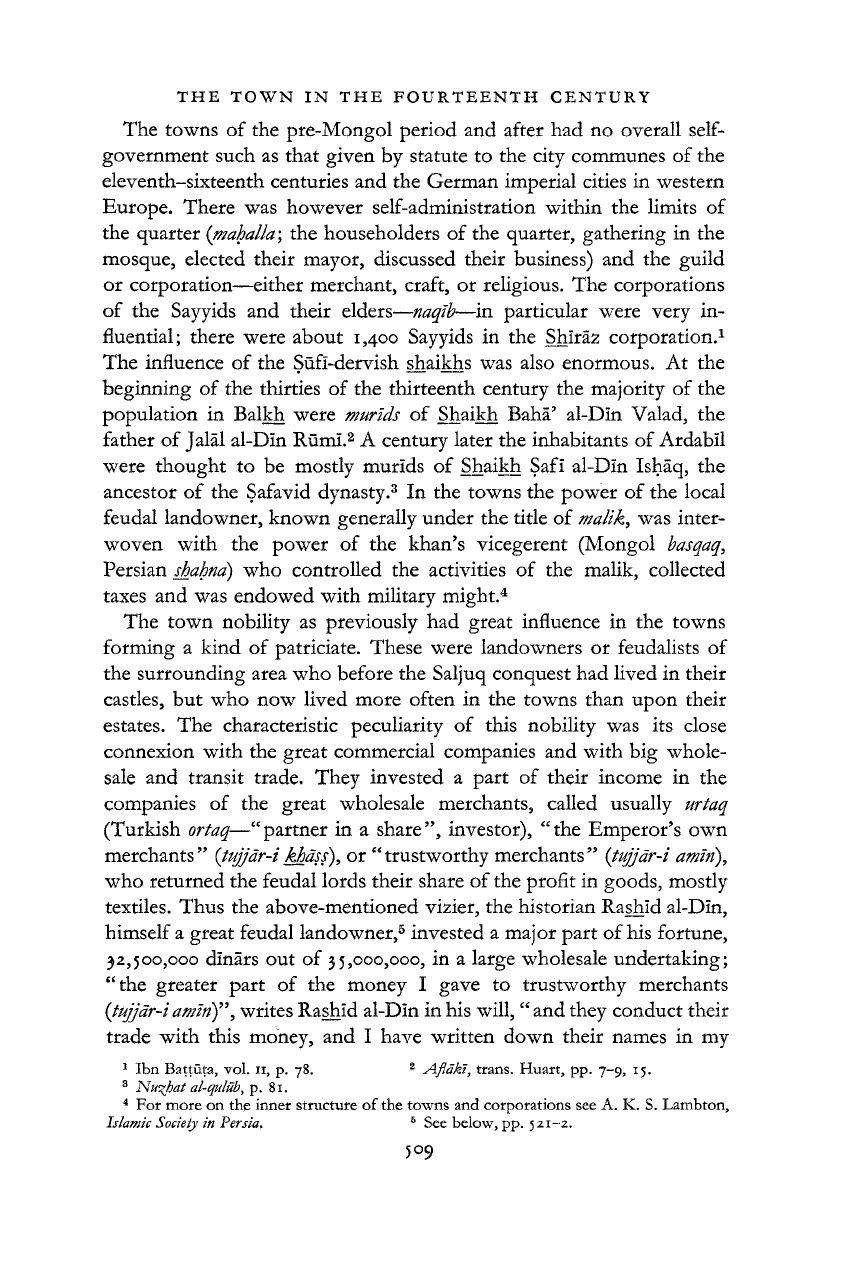
THE TOWN IN THE FOURTEENTH CENTURY
The towns of the pre-Mongol period and after had no overall
self-
government such as that given by statute to the city communes of the
eleventh-sixteenth centuries and the German imperial cities in western
Europe. There was however self-administration within the limits of
the quarter
(mahalla\
the householders of the quarter, gathering in the
mosque, elected their mayor, discussed their business) and the guild
or corporation—either merchant, craft, or religious. The corporations
of the Sayyids and their elders—
naqïb—in particular were very in-
fluential; there were about 1,400 Sayyids in the Shirâz corporation.
1
The influence of the Sufi-dervish shaikhs was also enormous. At the
beginning of the thirties of the thirteenth century the majority of the
population in Balkh were murids of Shaikh
Bahâ' al-Dïn Valad, the
father of Jalàl al-Din Rûmï.
2
A century later the inhabitants of Ardabil
were thought to be mostly murids of Shaikh Safi al-Dïn Ishâq, the
ancestor of the Safavid dynasty.
3
In the towns the power of the local
feudal landowner, known generally under the title of malik, was inter-
woven with the power of the khan's vicegerent (Mongol basqaq,
Persian
shahnd)
who controlled the activities of the malik, collected
taxes and was endowed with military might.
4
The town nobility as previously had great influence in the towns
forming a kind of patriciate. These were landowners or feudalists of
the surrounding area who before the Saljuq conquest had lived in their
castles, but who now lived more often in the towns than upon their
estates. The characteristic peculiarity of this nobility was its close
connexion with the great commercial companies and with big whole-
sale and transit trade. They invested a part of their income in the
companies of the great wholesale merchants, called usually urtaq
(Turkish ortaq—"partner in a share", investor), "the Emperor's own
merchants "
(tujjâr-i khdss), or " trustworthy merchants "
{tujjâr֊i
amïn),
who returned the feudal lords their share of the profit in goods, mostly
textiles. Thus the above-mentioned vizier, the historian Rashid al-Din,
himself a great feudal landowner,
5
invested a major part of his fortune,
32,500,000 dinars out of 35,000,000, in a large wholesale undertaking ;
"the greater part of the money I gave to trustworthy merchants
{tujjâr֊iamïny\
writes Rashid al-Din in his will, " and they conduct their
trade with this money, and I have written down their names in my
1
Ibn Battûta, vol. n, p. 78.
2
Aflâkï, trans. Huart, pp. 7-9, 15.
3
Nu^hat al-qulub^ p. 81.
4
For more on the inner structure of the towns and corporations see A. K. S. Lambton,
Islamic
Society
in Persia.
6
See below, pp. 521-2.
509
